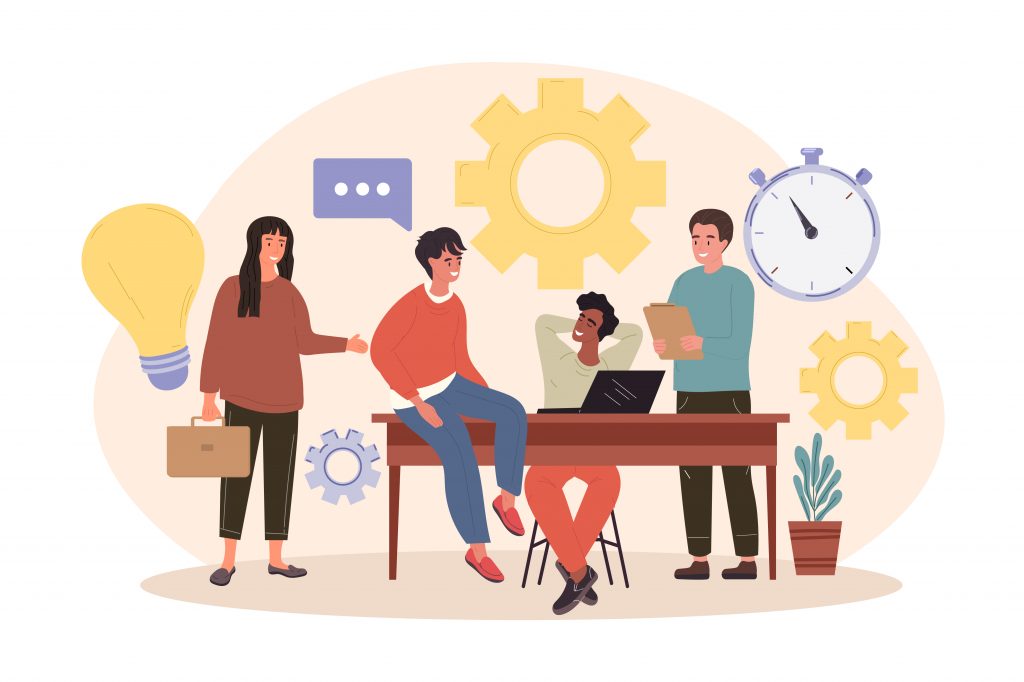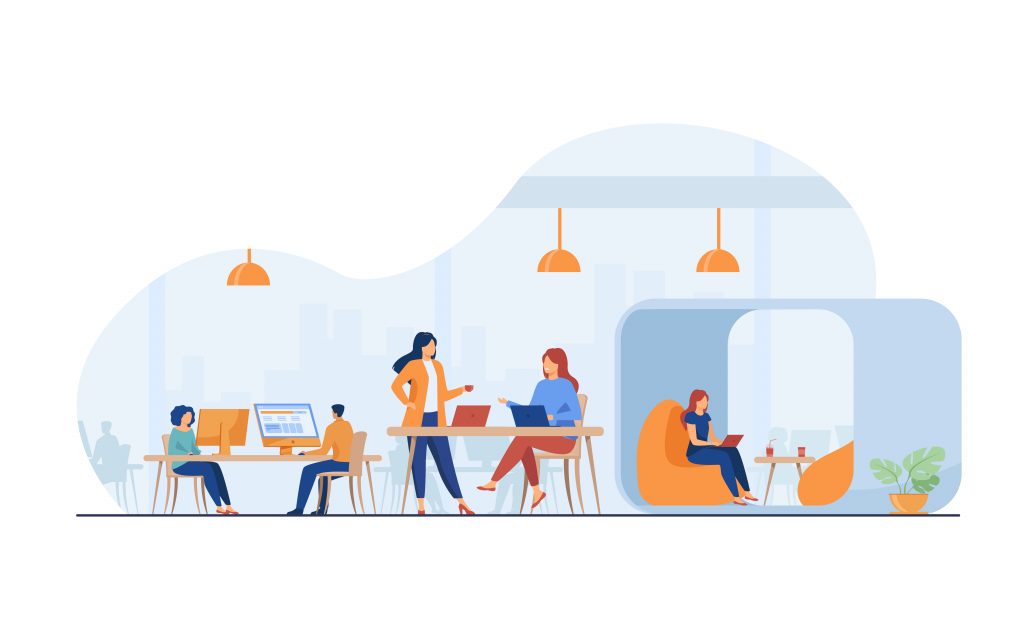
Human Rights & Employment Standards in the Workplace
In an era of unprecedented corporate power, can we still safeguard the dignity of every worker amid the relentless quest for profit?


CEO of Docutec
From cubicles to open floorplans, the modern office has undergone many evolutions. For decades, organizations have tried to unlock the key to greater efficiency by analyzing everything from the office chair to various seating arrangements and modern technology.
However, during the last couple of years, businesses experienced countless transformations in working patterns which challenged the whole purpose of the office.
Attracting employees back to the office in its traditional structure proved more difficult, especially in a tight labor market. Nowadays, organizations have a greater desire to refocus on their people, create collaborative environments, and support their well-being.
For these reasons, office design is emerging as a critical business tool that can increase productivity and attain top competitiveness. In this article, we explore how workplace design affects productivity and how the corporate workplace can be a place that offers both meaning and efficiency.
While there are countless definitions and ways to answer the question of workplace design, the simple explanation is that it’s about creating a safe environment for optimal productivity.
Workplace design is the process of designing, organizing, and planning an area to optimize and support employee performance, productivity, health, and well-being.
While the relationship between workplace design and wellness is becoming increasingly important, different work environments require original ideas and layouts.
In industrial settings, workplaces must be designed to ensure workers’ safety and accomplish tasks efficiently. While for office workers, employers are increasingly focused on creating spaces that will improve wellness by perfecting conditions such as air quality, noise reduction, and lighting.

Simply put, best-in-class workplaces aim to turn the office into a place workers won’t dread going to every day. This means creating a stress-free and comfortable environment so employees can produce their best work.
Discussions on the ideal office environment are endless, yet most companies haven’t properly acknowledged how workplace design affects productivity and utilize interior design to benefit their bottom line.
As many as 70% of offices are open floor plans with no walls or communication obstacles. Some embrace the open environment, while others complain about the noise, the loss of personal space, and the inability to concentrate.
Nevertheless, open office concepts have their strengths, as well as many weaknesses. The question of whether they function in real life depends on the ability to create personal spaces.
A significant downside of the open office is linked to psychological privacy, particularly the loss of control over the environment around us.
When workers can’t change how their personal workspace looks, adjust the lighting, or control temperature, it evokes a sense of helplessness.
Unsurprisingly, studies show that this significantly affects employee well-being, job satisfaction, and team cohesion.

As if that’s not enough, one even more problematic aspect of an open office is the physical, rather than psychological, noise. Noise pollution is more harmful than we think; a 10db noise increase –from dishwasher to vacuum – drops productivity by 5%.
Sound reduces cognitive performance and impairs workers’ ability to recall information or perform basic math.
In addition, constant noise and distractions make people feel tired faster and experience a sense of sensory overload. Many people find that absolute silence or quiet is vital to their productivity.
After understanding how workplace design affects productivity, the question arises: How can companies reinvent the workplace to meet the evolving needs of people while also boosting productivity?
Gone are the days when workers performed the same task for eight hours.
Over the course of an average work day, most employees alternate between a broad spectrum of tasks, such as reading, writing, emailing, attending meetings, group discussions, and brainstorming ideas.
Each productivity mode may require a different space, hence why today’s most recommended work environment model is the “activity-based office” layout.
One section of the office is designated for quiet cubicles, another is for phone calls or video meetings, and a variety of meeting areas for louder group discussions.
In the activity-based office, people can balance personal space and socialization to suit their tasks. For this model to work, it must be adequately implemented by providing spaces with various environments that support both collaboration and solitude for employees’ comfort.

Many office organizational practices assumed to be good for employee productivity have now been shown to have the opposite effect.
Today, a corner office with a city view is a status symbol of the past, and organizations are configuring the modern office for a flexible, agile, and multiuse purpose. In a nutshell, this involves planning shared spaces with an atmosphere of openness.
Innovation in the workplace is often a result of unplanned interactions.
Informal encounters between coworkers who otherwise do not interact frequently often lead to an exchange of ideas and knowledge creation. In fact, research shows that professionals get 80% of their ideas from casual interactions.
Environments where informal encounters are encouraged and where the workspace design promotes chance encounters end up having better teamwork and cooperation.
Knowledge workers spend one-third of their lives in an office, so companies must foster an environment that empowers people with the right shared spaces to think and collaborate naturally.

There are a few key aspects of workplace design that can have the biggest impact on productivity:
A wealth of research backs up the link between workplace design and productivity. Overall, results show that considering the ambiance of the office, ergonomics, and layout all affect employees.
It might seem intuitive that employees are more productive when their work habits are made public, but research shows that privacy loss is identified as one of the primary sources of job dissatisfaction.
Workers may feel uneasy when their peers and supervisors observe their routines.
Aside from discomfort, this lack of privacy may also limit the exchange of ideas. Many articles establish that employees have shorter and more superficial discussions when they know their conversation can be overheard or interrupted.
Furthermore, lack of privacy may contribute to health problems in employees as it allows the spread of germs and viruses. Workers in open offices took 62% more sick leave off work than employees working in individual offices.
Companies are addressing this issue through proper ventilation and controlling indoor air quality with purifiers.
How does workplace design affect productivity, and how does it impact concentration? Can companies really achieve greater collaboration and efficiency simply by rearranging desks?
Surprisingly, 97% of professionals reported their existing workspace design negatively impacts their ability to focus, with almost half (46%) describing it as ‘impacting heavily’ on their productivity. Lack of private spaces for focused work and visual partitioning to prevent distractions are cited as the most important to workers’ productivity.
Another research found that, on average, workers are interrupted every 11 minutes, and it takes a shocking 25 minutes to return to their original task after an interruption. As a result, a great deal of time is wasted in a day without even realizing it.
Stress, low morale, and an inability to concentrate are all reported as outcomes of poor workspace design. Distractions and similar impediments can be minimized and help to manage stress in the workplace when working spaces have an intuitive and intelligent design.

Productivity is significantly linked to job satisfaction.
Most employees want to produce their best work, and for that, they require certain factors – a comforting environment, healthy relationships with coworkers, good mental health in the workplace, and a focus on health and wellness, to name a few.
Workspace design is not just about showing off an impressive office; it also needs to be functional for employees.
While many employers offer employee wellness programs, many don’t realize that physical work environments can positively impact workers’ moods and overall wellness, thus boosting job satisfaction. According to one report, most workers (87%) want to work in a healthy environment with wellness rooms, company fitness benefits, standing desks, and ergonomic seating.
Greg Tuohy, CEO of Docutec, highlighted the need for ergonomic practices in the workplace by sharing, “The goal of ergonomic practice is to enhance the working environment so that routine tasks are conducted in a way that minimizes any potential health concerns and eases strain and tiredness.

Without a doubt, human-centered workspaces benefit and positively influence health, well-being, and employee satisfaction.
The COVID-19 pandemic dramatically changed how we work over the past couple of years. The shift to large-scale remote working started a global debate on the role physical spaces play within an organization.
With the rise of new working models, business leaders are faced with a rare opportunity to completely reinvent the workplace – and increase productivity. By focusing on humanizing work, they have a chance to re-engage their workforce, respond to shifting expectations of employees, and reshape the future of work.
What changes need to happen to the physical workplace design post-COVID to accommodate new ways of working?
Humans thrive on social connections and relationships in the shared physical space.
Microsoft’s research shows that, although employees’ immediate close network interactions increased during remote work, interactions with secondary networks shrunk. As a result, a cross-pollination of ideas and innovation will be happening at a slower rate.
Everything indicates that the physical office is still needed, but one unavoidable element will make employers and employees alike want to return to the office – flexibility.
Therefore, to fully take advantage of the benefits of the office, it needs to give employees flexibility in choosing where and how they work. Organizations must reimagine their workplaces holistically and with an approach centered around the employee experience.
Moving forward, the focus must be on how to design a hybrid workplace.
Since employees’ alternative working space is their home, organizations must focus on making the workplace safe, comfortable, and easy to navigate, encouraging collaboration, and having a “wow” factor.
Simply put, workers need a reason to get dressed, commute, and spend time in an office.
Employers must consider how they can reconfigure the office to optimize workflow and processes. The space should be customized for hybrid work with seamless collaboration tools and equipped with video-conferencing technologies to blur the lines between in-office and remote teams.
The process of booking focus rooms, quiet spaces, or smart conference offices needs to be intuitive, digitalized, and frictionless. The right technology and physical spaces merged with virtual experiences are crucial to assisting employees throughout their day. Moreover, employees want some level of control over their spaces, such as operable windows, fresh air, and shading control.
The office is not just a resource – but a hidden benefit that can serve your employees.

Pre-booking rooms, various amenities and facilities available, and high-quality food – sounds a bit like describing a five-star hotel experience, which is precisely the sweeping trend in workplace design.
“Hotelification” of the office represents a reinvention of the workspace drawing on inspiration from the warm and welcoming environment in the hospitality industry.
Offices are starting to reflect the comfort and aesthetic of hotels in an attempt to create the perfect employee experience.
In addition to these trends, businesses envision office design through ESG lenses.
Sustainable practices and eco-friendly efforts have become increasingly common by bringing in renewable energy, office plants, outdoor sitting areas, and recycling and reusing products. Green office trends call for the environmentally responsible and resource-efficient design of offices.
Trends in working preferences and workplace designs are not set in stone and will continue to shift. Moving forward, it’s vital that employers also consider the makeup of their workforce.
For example, Generation Y professionals are more than twice as likely to prefer open-plan offices than Baby Boomers or Gen X.
What’s more, as organizations look to entice skilled women to return to the workforce, they need to remember that women are twice as likely to be dissatisfied with their current workspace design than men.
Similarly, the size of the workforce matters to the type of design – employees working at large organizations are more likely to prefer partitioned open-plan offices than those working in small and medium-sized companies.
Sustainability, personalization, and experience must be built into the heart of the workplace design of the future.
Research shows how workplace design affects productivity; the only thing remaining is whether or not leaders will realize this as a most promising competitive advantage. Today, money is no longer the primary motivating factor for employees; many see their jobs as an experience.
As such, companies can improve the employee experience through their office design and consequently improve productivity.
Browse our curated list of vendors to find the best solution for your needs.
Subscribe to our newsletter for the latest trends, expert tips, and workplace insights!

In an era of unprecedented corporate power, can we still safeguard the dignity of every worker amid the relentless quest for profit?

With rising gas prices, soaring car maintenance and used vehicle costs, commuting to the office has become a costly burden that drains employees’ finances, productivity, and satisfaction—making commuter benefits a vital solution for employers.

Value-based connections, hybrid events, expansion of AI, and the metaverse. In the ever-expanding networking realm, here’s what to look out for in 2025.

Why are your employees leaving? Asking the right exit interview questions reveals the pattern behind high turnover and transforms offboarding into a roadmap for retention.
Used by most of the top employee benefits consultants in the US, Shortlister is where you can find, research and select HR and benefits vendors for your clients.
Shortlister helps you reach your ideal prospects. Claim your free account to control your message and receive employer, consultant and health plan leads.